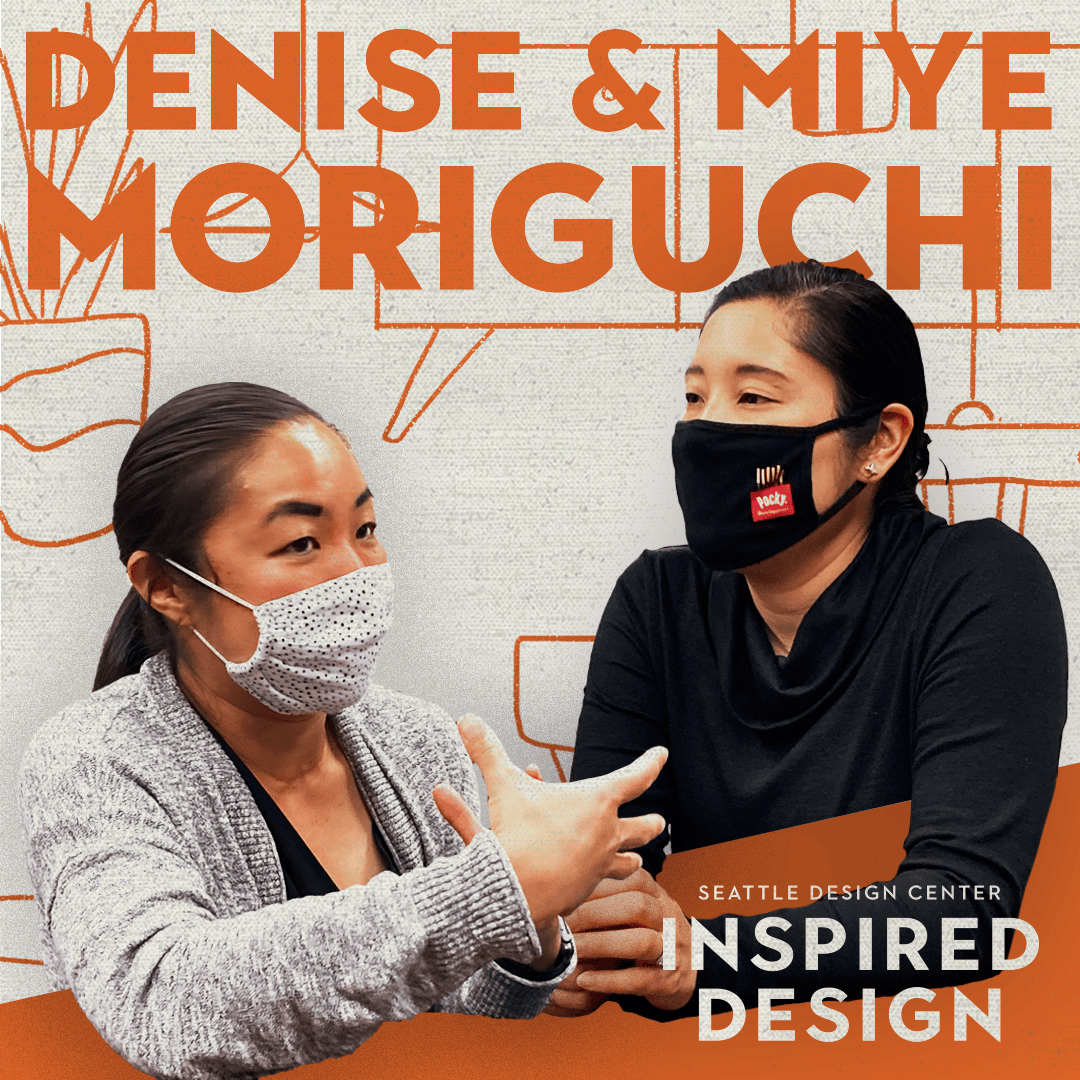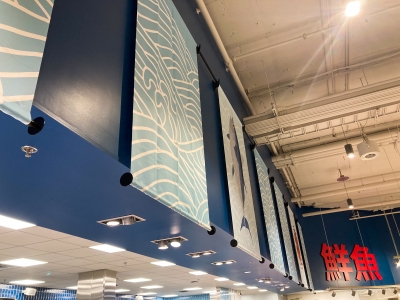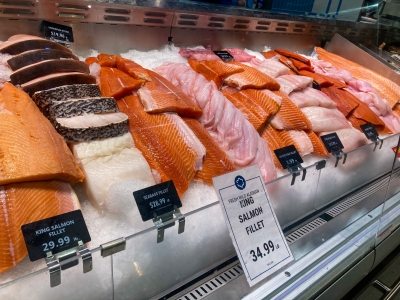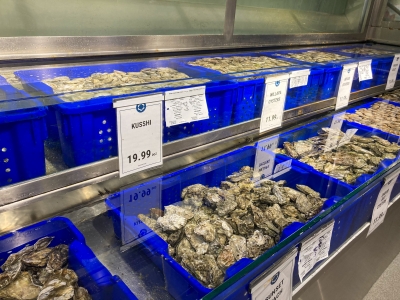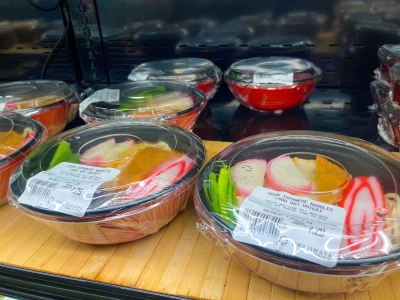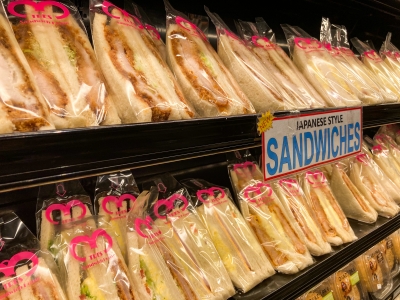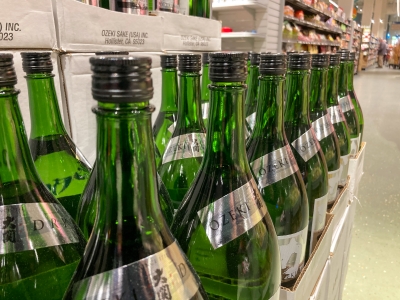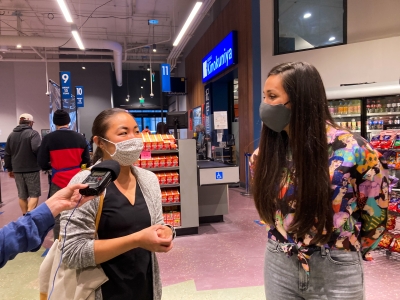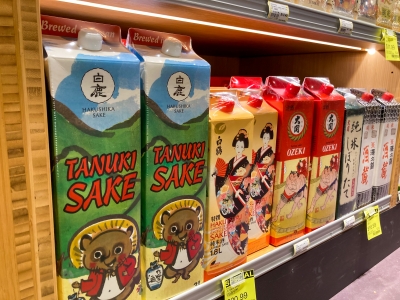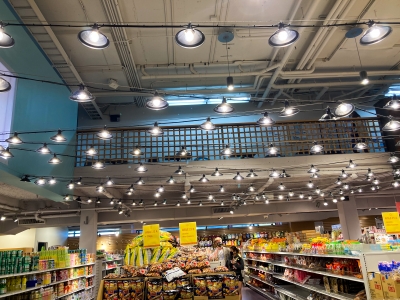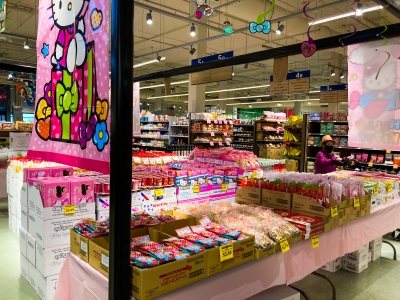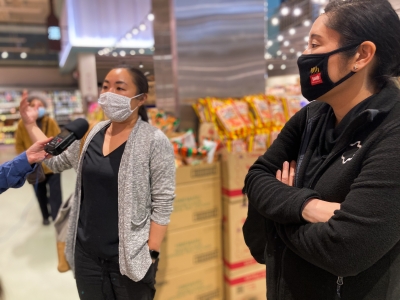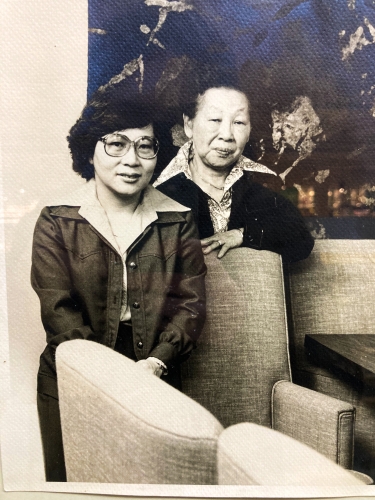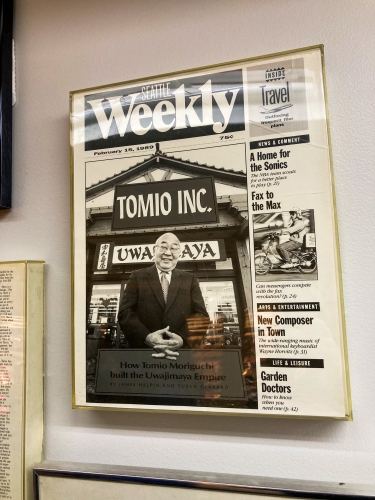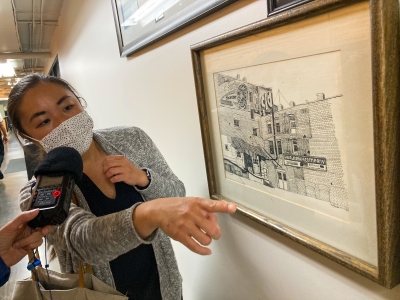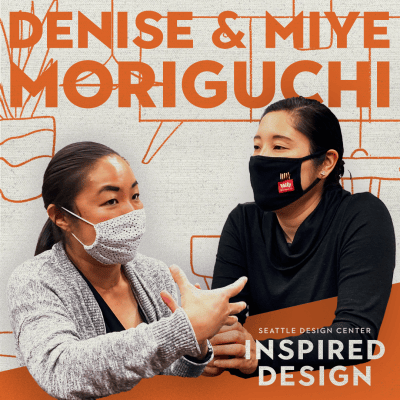
On this episode of Inspired Design join us as we get an inside look at one of the most iconic PNW family-owned establishments, the Flagship Uwajimaya Market. Denise and Miye Moriguchi, the 3rd generation powerhouses leading the business, tour us through the much-loved store while teaching us about its less-known past. Uwajimaya is synonymous with the Moriguchi family’s history, a macrocosmic look at how the market has both changed and stayed the same throughout its existence.
Episode Transcript
Denise Moriguchi:
In 1962, when the Seattle World Fair was in town, my grandfather really wanted to have a presence there. Even though we never got to meet our grandfather, I feel like that was his moment where he decided he wanted to sell to more than just Japanese customers, but really share Japanese food and culture with everyone. I think that’s a moment I think about often and how it’s probably changed the course of who Uwajimaya is today.
Gina Colucci:
I’m Gina Colucci with the Seattle Design Center. Every week on Inspire Design, we sit down with an iconic creator in a space that inspires them.
Mia Moriguchi:
We are at the Seattle flagship Uwajimaya store. This is actually the third physical location in the district.
Gina Colucci:
This week, I met up with Denise and Mia Moriguchi, the powerhouses behind Uwajimaya. Their grandfather started the business out of the back of his truck in 1928. And just last year, Mia and Denise led the company through a $10 million remodel.
Mia Moriguchi:
This latest effort that just completed in October of 2020 was our first major refresh of the store since 2000.
Gina Colucci:
Their story spans generations and decades.
Mia Moriguchi:
This is Denise’s dad and my uncle, right there and another uncle of ours so there were seven siblings.
Gina Colucci:
It is a triumphant one, but not without heartbreak.
Mia Moriguchi:
My father, Denise and the whole family just worked so hard.
Gina Colucci:
Let’s start from the top.
Mia Moriguchi:
We did just enter through the new entry. This is brand new to the store. It used to be part of the produce department and just a rotunda, but we really felt this more grand entry into our produce department was something that would really excite people as they walked in.
Gina Colucci:
Mia studied architecture and design at Yale and worked at a Seattle design firm for 11 years before joining the Uwajimaya leadership team.
Mia Moriguchi:
We really are proud of our produce selection, especially the Asian greens and gingers and mushrooms and all these types of varieties. It changes seasonally so that’s really exciting. And then, if we walk that way, so part of it was really trying to orient customers as they’re walking in. So when you do walk in, not only do you see the produce department, but you can see our meat department and all the way back to our seafood department, which is one of our most proud departments for sure and just the unique kind of character of Uwajimaya itself.
Gina Colucci:
I have to stop here for a second because in that moment, I realized that I had one foot in the present store, a beautiful modern space with thoughtful design elements, but I also had one foot in the past. Uwajimaya has so much history if these walls could talk. I mean they were talking. The backstory of this space and business and this family just pours out of the walls and creates the energy in the air. As we go on our tour, we keep jumping back and forth through time to tell Uwajimaya’s whole story and how these two powerhouse women are at the helm of this company’s next chapter.
Denise Moriguchi:
Uwajimaya was started by our grandparents, Fujimatsu and Sadako Moriguchi.
Gina Colucci:
This is Denise, Uwajimaya’s CEO. She got her MBA from MIT and returned to Seattle to join the family business in 2013.
Denise Moriguchi:
Our grandfather came from Japan then like many immigrants, he was looking for job and better opportunity. So he arrived in Tacoma in the 1920s by boat. There were Japanese bachelors working in mining and fishing and logging camps and he went to where they were and sold them fishcakes. That was his kind of like specialty. So Japanese [foreign language 00:03:40], and then he’d sell them rice and soy sauce. Then as these bachelors started getting married, he opened a store because it now was a different customer shopping. It was the wife. So they opened their first store in Tacoma in the 1920s.
Gina Colucci:
Uwajimaya’s humble beginnings are in sharp contrast to the large team responsible for the multimillion dollar renovation that Mia is telling me about. I used to come here all the time and I had my office right down the street. One thing I do notice is the update of colors.
Mia Moriguchi:
Yes.
Gina Colucci:
How much thought and planning went into picking the right green and the right blue and the right yellow?
Mia Moriguchi:
No, very good point. We worked with a very talented team of designers, and starting with our kind of our new brand expression. So we have some updates on that. Then Hoshide Wanzer Architects were our main architect firm, and then we worked with Cushing Terrell for kind of layout and grocery store layout and design and such, and Bruce Hale for our brand and imagery. It was a very collaborative approach to all of that, but really the overall is we kind of neutralized the palette that used to be here I would say, but wanted to really bring to life some of the certain departments and kind of distinct areas, but in a more intentional way. So we do have a pretty bright green in the produce. We have these large banners. This is an artist from Japan that we found and he had these amazing, beautiful illustrations, so much texture, but also really just it felt right when we saw his work and so we commissioned some of these pieces for this store.
Gina Colucci:
So when I look at these four beautiful banners up above the produce section, you nailed it. They have this great texture to it with these designs. They’re beautiful, but I wouldn’t know that’s an actual Japanese artist. That’s really cool.
Mia Moriguchi:
So you continue through the meat department and you really see all of this beautiful meat, all the cuts. There’s Jesse. So we have much of a more defined meat department, but we do offer a lot of specialty cut meats, so the thin slice meats, pork and beef, and then of course our really high-end Wagyu style beef over there.
Gina Colucci:
And that’s something that you can’t get in a normal grocery store?
Mia Moriguchi:
Nothing up to that amount of it, for sure, or variety I would say. Yeah. [inaudible 00:06:23] … some seasoned pork, so already made for dumplings if you wanted to make the dumplings. It kind of skips a step, which is really nice for [inaudible 00:06:33] … very busy. So our sashimi department, we have restaurant grade quality sashimi fish here, and we really wanted to distinguish it from your experience buying it there at this counter versus buying it at the more fish market type of environment. So we enhanced this, we call it our sashimi island, and it features a house-made poke every day. You can see the sashimi cutters at the corner here cutting expertly, these pieces of fish, and then you can pick them up to go home on all the way around it.
Gina Colucci:
As we’re walking by, people know you. Your workers know you. They’re waving. They feel comfortable. They’re excited to see you. How does that make you feel?
Denise Moriguchi:
Oh, it’s fun because we’ve kind of grown up in the store. So actually some employees they’re like, “I remember when you were this tall,” and it’s to their knee, but it’s just been fun seeing people just be here for so long. We’ve got people who’ve been here 10, 20, 30, 40 years. So we just got to know them and they’re like our family. So it’s nice.
Mia Moriguchi:
They also run into about five family members a day if you were here. We’re moving into more of our deli offerings. I would say our [foreign language 00:07:51], our grandmother would probably be just astounded at what the kitchen and the deli looks like today. We remember her in the old store. She would make lunch for all of the employees every day, and she would hand roll the sushi rolls and the curries and all of the different dishes. That’s what I remember her. She would be in that back corner of the store making lunch. So now, it’s really this place to find all types of different foods ready to eat. We have our sushi, our… Let’s see. We have noodle bowls over here. We have all the kind of, a lot of the traditional side dishes that you find in Japan and different… We have shumai and Vietnamese spring rolls. Yeah.
Gina Colucci:
And back to your grandmother. What do you think she would say?
Denise Moriguchi:
[crosstalk 00:08:49] I think she’d be so proud and just amazed at the volume of products, but also how diverse our customers, employees have become, and that the business has grown since my grandfather and grandmother first started it.
Gina Colucci:
After starting the company, me and Denise’s grandparents had a relatively quiet season of life, about 20 years spent growing their business in the original Tacoma location.
Denise Moriguchi:
With the outbreak of the war, my family was sent to Tule Lake internment camp in California. So they had to leave their business in Tacoma and went to California.
Gina Colucci:
Tule Lake was one of 10 concentration camps built to imprison Japanese-Americans forcibly removed from the west coast during the World War II. It was also the biggest. By the time it closed on March 20, 1946, more than 18000 Japanese Americans had been incarcerated there during the war.
Denise Moriguchi:
And then after the war in the forties, they had to start all over again. So my grandfather heard more people are moving to Seattle versus going back to Tacoma. So he went to Seattle and he opened his first store we mentioned on 422 South Main Street, so just not too far from where we are today. They rebuilt their grocery business, started with a little kind of hole in the wall store. When the next door business moved out, they kind of lease that space, knocked down a wall and expanded their business.
Gina Colucci:
And they kept expanding their business one project at a time.
Denise Moriguchi:
Our first store was in Seattle. We opened a store in south center in the, I think it was seventies or early eighties. We opened a store in Bellevue also in the seventies. We opened a store in Beaverton, Oregon in 1998. We opened a Renton store in 2009. We moved our Bellevue location 2011 or ’12, so where it is right now. Yeah, we remodeled the store recently. So I don’t know what else. Let’s see. [crosstalk 00:11:05].
Gina Colucci:
I was captivated by the whole… There’s just so much history. It’s a quintessential Seattle base, but what really caught my attention was back in the 1920s with your grandfather being a very smart businessman, realizing, “I’m selling these cakes, but now my base is growing,” and I can kind of see that that’s genetically stuck with you, now both of you very savvy business people.
Denise Moriguchi:
Yeah. Definitely, I think we’re proud that our grandparents had insight to really want to appeal to a diverse customer base. But I think another thing we’re really proud of is that our grandparents always made sure the community and the customer were really… They were the most important thing that they wanted to focus on.
Gina Colucci:
I asked me and Denise how they think about their customers today.
Mia Moriguchi:
We talk a lot about our two kind of groups of customer base. We call them the loyalists. The ones that I’ve known as grown up with us, kind of know the cuisine and we know exactly what they want to be buying, and maybe they’re very loyal to certain products like you said. Then we have the explorers who really are discovering new things all the time. Frankly, you can have somebody that does both. They may know very much about Japanese food, but are learning about Vietnamese foods or something like that. But for the explorers, we really want to make sure that they’re getting information and understanding and learning about new products and seeing new things. Then for the loyalists, we want to make sure they have their staple product for a good price, good selection, make sure it’s in stock, but also maybe introduce them to some new things.
Mia Moriguchi:
We talked a lot about customer flow. We recognize we’re in a very urban environment being in the heart of the Chinatown international district, but we are a grocery store. So to the south, we have the parking lot, and a lot of people park and get their shopping cart and go shopping. To the north it’s South Weller, which is a very more intimate pedestrian street. That’s where all of our food hall vendors, they have small store fronts that open up to that neighborhood. So a lot of the customers coming from that way, maybe they work in the neighborhood, they live in the neighborhood and they’re on foot, and maybe they pick up a smaller shopping basket and getting their food for lunch or snacks for tonight or something like that. So they may have very different needs.
Mia Moriguchi:
That’s a lot of the impetus of why we put the entry there and then had that really straight shot. We call it the spine of our store, which is really connecting produce, meat and seafood together in that kind of one environment. Then connecting from the Weller side a little bit more is from the food hall, all the shops, the small shops there kind of snaking around to the sake and beer to that street and continuous of that. So definitely setting off kind of those two experiences within the same store was a lot we talked about.
Gina Colucci:
If you could have a shopper feel like one emotion or one thing when they walk in here, what would that be?
Mia Moriguchi:
Be transported. Too shocking. I don’t know.
Denise Moriguchi:
We talked internally a lot about East discovery and delight. So in discovery, especially for the explorer and making it easy for the loyalist and we want the whole experience to be delightful for all customers. So we really do, we like that discovery feel. We hear stories about our grandparents. So when new would come to town and they didn’t have a place to eat or sleep and they’d be like, “Oh, go see the Moriguchis at Uwajimaya,” and my grandparents would give them a job and let them sleep on the couch and feed them. So I think taking care of customers and being part of the community is something that was really important to them that’s been passed down. So even though we didn’t meet our grandfather, we just know the values that were really important to him that we feel have made Uwajimaya continue to grow and be part of this community.
Mia Moriguchi:
Being in the Chinatown international district is especially important in the city of Seattle, but also our family. Really it was place of our business for so long. We spend so much time down here looking at design and development and how the neighbor has been changing. It is really being part of that conversation has been really important to me especially, just have such a big stake family wise, community wise, and the city is changing so much that I think it’s really important to be in the middle of those conversations. It’s such a diverse community and clearly with lots of different ideas and thoughts and direction and such, but that’s what makes it so interesting and so vibrant. Going through this project and other projects in this district, you realize there’s no other district like this in Seattle. I would say even across the country.
Gina Colucci:
I know that you’ve gone through the larger part of the renovation. Are there still things that you’re going to add?
Mia Moriguchi:
For sure. Yes. We’re working right now on a more, we call it kind of the secondary signage elements, really trying to connect people with food. So there’s a lot of overwhelming products here. A lot of the questions are, “What do I do with this? How do I cook it? Do I eat this raw? Do I cook it? How long?” So trying to connect people with those foods, and we think we can do that in a variety of ways. One being signage components. There’s some way finding signage, but also here’s so-and-so’s favorite sake, or this kind of tastes like chicken. You should try it, or that kind of thing. So we’re working on that. Some of the signage could be showcasing our local vendors. A lot of our bakery items come from Seattle based, born and raised kind of bakery items. We have the Cakes of Paradise, the hood famous bake shop in here. I don’t know. Do you want to go check out that way? [crosstalk 00:17:11]
Mia Moriguchi:
So we’re in our, what we deemed as our retail street. Here, this is all the products that are much more exciting in a way. We have snacks to our left here with just the tons of varieties of different Asian snacks, rice cake, rice crackers, mochi, all those different flavors, Pocky. This is a more fun environment. I think you talked to lots of kids who grew up in Uwajimaya and this is what I remember. You go to the snack department and you pick out all your [foreign language 00:17:42] and your rice crackers. [crosstalk 00:17:44] Yeah, exactly. So we really want this to be a kind of a very different feeling than when you’re buying snacks and say, you’re buying your fish. So we call this kind of our retail street. So it starts with the Saki and beer and beverages, all of the Japanese teas and different specialty beverages there. It moves into our snack selection, which is piled high with products and a little bit on the messy side where it’s just a different feel.
Gina Colucci:
I definitely get that. Kind of you’re feeling almost like you’re at a street market with the lights and the variety and the colors. Do you have one item that’s still here that you just remember as a child?
Mia Moriguchi:
Oh, yeah.
Denise Moriguchi:
Well the [foreign language 00:18:28], that one right there. This is from… I don’t know how long they’ve been making this. It used to have a toy in it. Now, it has a sticker, but I remember getting this all the time when I was a kid and now I buy it for my kids all the time. I think it’s been around since, oh gosh… I should look it up. I feel like at least over 50 years, if not a hundred years. I don’t know.
Gina Colucci:
Is there anything else that really just like transports you back to your childhood?
Denise Moriguchi:
Oh, that one. This drink over here, it’s like a very popular drink in Japan at fairs and festivals. There’s a marble on the top that’s holding it kind of together and you pop the marble down and it releases the carbonation. So this is a really fun drink we’d have when we were a little.
Gina Colucci:
So when you bring your kids here, they’re kind of experiencing kind of what you did just in a different generation. So what is that like?
Denise Moriguchi:
They’re always so excited to come pick out snacks. My dad used to make me pick up garbage and stuff when I was here, and I make them and I make them do that. So it’s just fun to see them kind of understand this is part of their family and who they are, so they can take pride in it and also help keep it clean. I don’t know. But they just love coming here with me and finding new fun products. They always want candy or some kind of cookie snack. [crosstalk 00:19:53].
Mia Moriguchi:
That’s why I don’t bring my kids here.
Gina Colucci:
A quick lesson in the Moriguchi family tree. Denise and Mia’s kids are the fourth generation. Besides stocking up on candy and picking up trash, they’re too young to be a part of the family business. Although, both Denise and Mia told me that they hope the fourth generation wants to get involved. They feel a sense of duty to keep growing and innovating the business. So the fourth generation is excited to step in and doesn’t feel burdened. Back to the family tree. Denise and Mia are the third generation. There are nine cousins and spouses involved in the company in some way. Denise becoming CEO was the official transfer of power from the second generation, their parents, aunts, and uncles to the third generation.
Gina Colucci:
You have some very powerful women in this family.
Denise Moriguchi:
Yeah. I chuckle often our grandfather was more traditional in the sense that when he did leave the company, he left it to his four sons, even though there were three daughters and four boys. He gave each son 25%, which that was actually kind of progressive for his age because usually it just went to the eldest son, but it did end up with the girls. So I kind of left some days thinking about now how his youngest daughter ended up running the company for several years, and we have a number of strong women at the company from our family.
Denise Moriguchi:
We should note, so our generation there’s 19 of us and then 15 of us are female. The numbers just kind of fell in our favor. So it’s not really that surprising that we have so many women cousins working in the business, but I don’t know. I feel the family is very supportive of it, and especially our aunt Tomoko who’s the youngest sibling who ran Uwajimaya for many years. She’s just very outspoken and won’t take crap from anyone. So I think she really paved the way for us. It’s not so surprising now because she’s already like put them in their place and told them, “Shut up.” Females are here to run the company. So she blazed the trail for us.
Gina Colucci:
Also, you said that was your aunt, but your grandmother who said she was pretty elderly and still getting on the bus coming here to work. That’s dedication. That’s a powerful woman. [crosstalk 00:22:23] Yeah.
Denise Moriguchi:
Yeah. She was really the backbone of Uwajimaya, just kept the place running. When the siblings were running it, there’d be little squabbles, but she would make sure that you remember it’s family and everyone still loves each other. So she was definitely a very impactful force and driving force to the growth of Uwajimaya.
Gina Colucci:
Yeah. Speaking of her, and this is something… She had four children in a Japanese internment camp. [crosstalk 00:22:55] Your grandmother- [crosstalk 00:22:57] Oh, she gave birth to- [crosstalk 00:22:59]
Mia Moriguchi:
Two children.
Gina Colucci:
Can we go a little bit into- [crosstalk 00:23:02].
Mia Moriguchi:
Sure. Yes. My grandmother gave birth to two children in Tule Lake in the internment camps. One, which was my father in 1944. So, yes. Talk about a very strong woman. But she did have four children when they went to Tule Lake- [crosstalk 00:23:24] … and then she had two more.
Denise Moriguchi:
Well, there’s seven total. [crosstalk 00:23:28].
Mia Moriguchi:
No, because [inaudible 00:23:30] Japan.
Denise Moriguchi:
Yeah.
Mia Moriguchi:
Yeah, so they had another daughter who was in Japan at the time and then came back and joined. So there’s seven total siblings, all of who grew up in Seattle, went to Garfield High. So we’re very rooted in Seattle.
Gina Colucci:
Wow. Japanese internment camps is not something I learned about until I was older and it’s not something that’s talked about that much, which is very unfortunate because we need to learn from that. How do you feel about it and how do you kind of… Have you told your children about it yet?
Denise Moriguchi:
So my father went into the camp, I think when he was around six and that’s the age my son is now. So I look at my son and think, “Gosh, how would he manage it?” But we have talked about it. There’s been a lot more awareness. I feel like in the past several years, but it’s something my grandmother never wanted to talk about. It was kind of a period she just wanted to put behind her. So I learned about it in school as well, really.
Mia Moriguchi:
Tule Lake’s really interesting. It’s the No-no group. From what I remember, you had two questions you were asked. Do you pledge allegiance to the U.S.? And if you had the chance, would you go back to Japan? And if you answered no to both of those… Would you stay in the U.S. or something like that. So it was like if you said no to both of those, they sent you here. So really, I think if the war extended, many of those families would have been probably sent back to Japan. So they were treated in a different way too.
Gina Colucci:
The No-no group that Mia mentions, that’s based on inmates’ answers to an infamous, “loyalty,” questionnaire. The survey was flawed from the start. The questions were ambiguous, and just about any answer got you labeled as disloyal. Because of this, Tule Lake became a segregation center and was then under maximum security. It was ruled under martial law and occupied by the U.S. Army.
Mia Moriguchi:
I remember going to California with my family trip to Tule Lake, nothing to see, a barbed wire fence and dust. And I’m sure that’s exactly how it was back then, too. So we did talk about it. I know it wasn’t a intensive conversations by any means, but I think it was something that always he clearly doesn’t remember much as being just a baby, but IT for sure shaped the family and everyone for sure.
Gina Colucci:
I asked how their relatives’ time at Tule Lake shaped their family. Denise and Mia told me that the whole family just worked so hard. It was always about work and family. They saw the impact this had on their parents, aunts and uncles, even though they were largely sheltered from the peaks and valleys of running a family business. Denise and Mia both took on their roles at the head of the company knowing how hard a family business can be. They both agreed the lows are low, but the highs are high.
Denise Moriguchi:
One of our family traditions used to be making mochi. Mochi is like a rice cake, but you have to eat it on New Year’s in Japanese in culture. Now, we can buy it and it’s easily available from other places. But before that, we used to get together the week before… I guess in between Christmas and New Year’s and we come after the deli was closed and we’d all have different roles. Our uncles would be pounding the mochi, so the rice would get into a kind of… I don’t know. What do you call it?
Gina Colucci:
Paste?
Denise Moriguchi:
Paste, yeah. Then some people would cut it. Some people would flip it. I was a young kid, so I just kind of flipped the mochi to help it cool. Then we got older, we would wrap it, put it on the trays and wrap it. So we did that for several years. So we’d do that, we’d eat dinner, we’d stay. I don’t know. It felt really late. It would probably was only like 10 or 11, but we were young. [crosstalk 00:27:30].
Denise Moriguchi:
Then we’d get together for Christmas Eve dinner. We’d get together for Christmas morning brunch. We’d get together for Christmas dinner. Now, since our family’s grown so much, we don’t do it to that extreme. But I just remember those times fondly of everyone being together, making the mochi and working in the store. I remember Mia’s dad out in the parking lot directing cars with his high vis vest and my dad would be pushing carts. The holiday is definitely our busiest time and we all just kind of come and help. My brother works in the fish department in the holidays and it’s a fun time.
Gina Colucci:
Hey, what’s your favorite item you can only get at Uwajimaya? Head to Seattle Design Center’s Instagram post for this episode and tell us about it. Inspire Design is brought to you by the Seattle Design Center. The show is produced by Larj Media. You can find them at larjmedia.com. Special thanks to Michi Suzuki, Lisa Willis and Kimmie Design for bringing this podcast to life. For more, head to seattledesigncenter.com where you can subscribe to our newsletter and follow us on social media. If you’re looking for inspiration, come check out the Seattle Design Center in Georgetown. We’re open Monday through Friday nine to five. On the next episode of Inspire Design, we get a look at Tom Douglas’s favorite place to cook, his home kitchen.
Speaker 4:
Well, the first day we walked in, the mountains, it was crystal clear out there. [crosstalk 00:29:03] The mountains were snow capped. It was November. It always reminds me of that day we walked in here and then- [crosstalk 00:29:10]. We couldn’t afford the house and we did it anyway.


